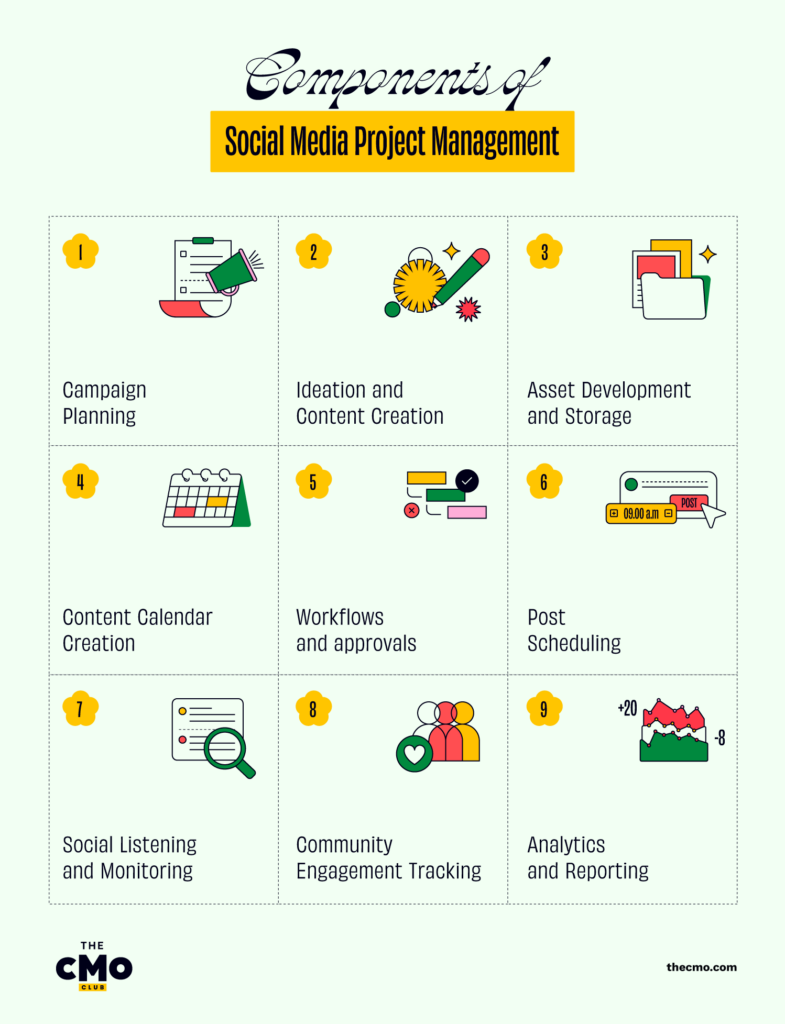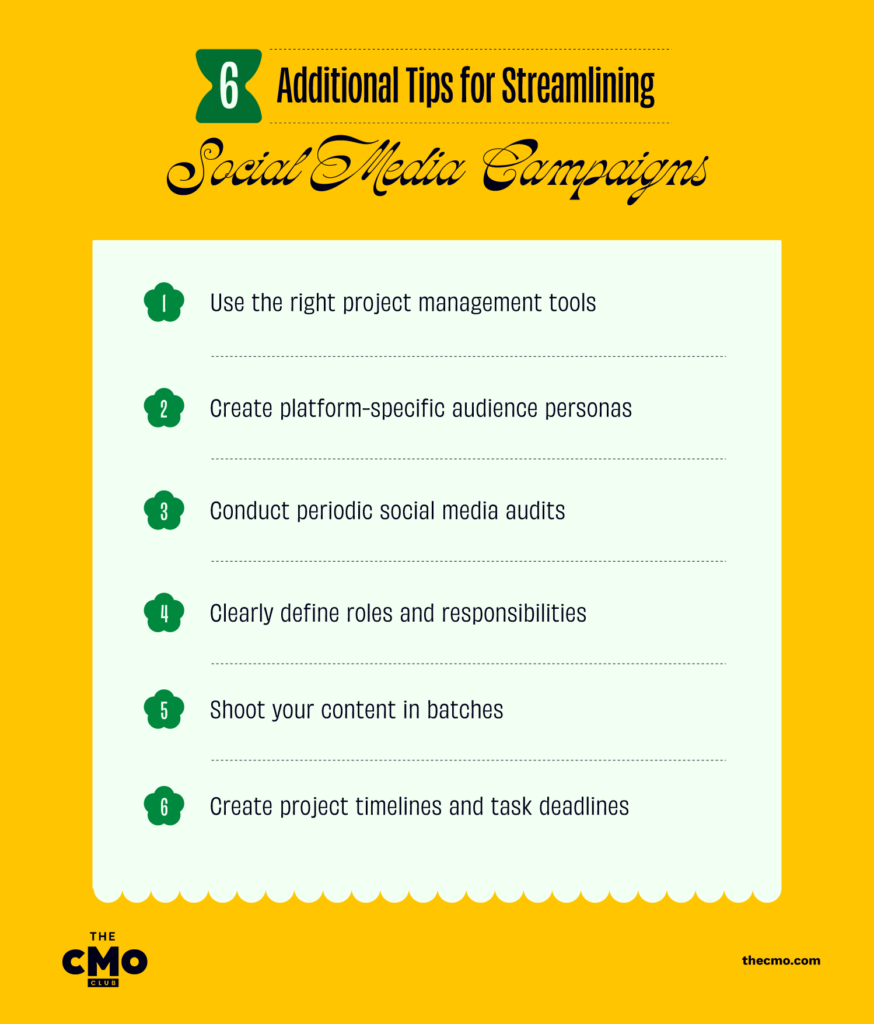As a professional social media marketer with nearly a decade of experience, I can say the industry has become equal parts rewarding and frustrating.
Unfortunately for those working hands-on in this field, social media’s changing nature means you need to be even more on top of trends than anyone else in your marketing department, and arguably even more adaptable, too.
Having good systems in place can help you remain organized, work effectively towards specific key performance indicators (KPIs,) and let’s face it, stay sane every step of the way. Enter, social media project management.
What Is Social Media Project Management?
Social media project management involves organizational techniques that span the entire social media management process, from initial ideation to content creation to content scheduling, and monitoring success after the fact.
It provides you with smoother processes as you aim for desired outcomes on social media, all while hopefully eliminating overwhelm.

Social Media Project Management vs Traditional Project Management
Unlike traditional project management which is designed for predictability with milestones, timelines, and neatly scoped deliverables, social media is live, and most importantly, it’s customer-facing in real time.
That means your “projects” are dynamic, ongoing interactions that require spontaneity, responsiveness, and emotional intelligence. One unexpected comment can trigger a content pivot. A trending hashtag can demand immediate engagement. And all of it has to align with brand voice, legal guardrails, and cross-functional stakeholder expectations.
In short, social media project management is about building systems that can move at the speed of the customer, respond in real time, and still deliver strategic outcomes. It's part execution, part improvisation, and always live.
Components Of Social Media Project Management
There are nine major components of social media project management:
Campaign planning
Social media campaign planning involves strategizing and organizing initiatives to achieve specific marketing objectives in your social media growth strategy. This is a crucial step in project management because it provides a roadmap for the entire project so your efforts are always aligned with overarching goals.
To implement an effective social media marketing plan, start by clearly defining your campaign objectives, target audience, messaging, and KPIs, conducting thorough research on audience preferences, competitor activities, and industry trends to inform your strategy.
If you’re working with others on the campaign, you’ll want to break things down into actionable steps at each level, assign responsibilities, and set deadlines for each party involved.
Ideation and Content Creation
This is where all creative ideas get brainstormed and the strongest become reality. In 2025, engaging content is a must for brands looking to make an impact on social media, so starting with an organized ideation process can help ensure you’re only moving forward with the best of the best.
My favorite method for coming up with solid social media content ideas is to do a three-round brainstorm:
- Round one: Foster an ongoing culture of creativity within your team by encouraging idea-sharing in a judgment-free zone. All ideas—good and bad—get added to the board at this point.
- Round two: Narrow that list down into content ideas that have more potential than others, and cross out the ones you don't think quite work.
- Round three: Zone in and expand on the ideas with the most creative promise of helping you reach your goals. Those will become real content!
Asset Development and Storage
Developing and storing assets involves creating and then organizing visual elements like images, video, and other multimedia, that will be used in your social media campaigns.
To stay organized in the asset development stage, a program like Canva allows multiple team members to create and work within pre-approved branded templates to help maintain consistency across multiple media formats. I also love how accessible it is to use for team members at different skill levels.
While you can also save and store your projects within Canva, you could alternatively implement a more centralized, cloud-based system for storing and managing assets with Google Drive or Microsoft OneDrive, which are free depending on your storage needs. I recommend developing guidelines for asset creation first, so you can streamline the production process and maintain visual consistency, no matter who works on a project.
Content Calendar Creation
A content marketing calendar is a digital marketing schedule that outlines the timing and topics for various content like social media posts over a specific period of time.
Creating a content calendar is an essential step in social media project management because it helps you plan content distribution while maintaining consistency in your brand’s messaging across all platforms.
To implement an effective content calendar, follow these steps:
- Identify the best times to post on your accounts. According to Later, in 2024, the overall best time to post on Instagram is 4AM (calculated in local time across time zones).
- Jot down the unchangeable dates like business anniversaries, holidays, and annual industry trends that are relevant to your brand and audience.
- Solidify your content pillars based on your campaign objectives and target audience preferences. This involves figuring out the types of content you’ll be posting — from educational to promotional, and everything in between.
- Use a digital spreadsheet or social media management software to organize everything you’ll post and when.Just remember to leave some wiggle room in your calendar for emerging trends, unexpected influencer shout-outs, or any other last-minute content that deserve a spot in your feed.
Workflows and approvals
Workflows and approvals refer to the process of creating, reviewing, and approving social media content before it's published, to help you achieve more quality control within a team atmosphere.
To set up this kind of process within your team, you’ll need to establish and delegate clear social media team roles at every level — from design to copywriting to overall strategy.
Don’t overlook good marketing collaboration tools like Slack or Zoho at this stage, as they’ll be key at streamlining team communication.
Post Scheduling
Using a social media scheduling tool ensures all your content gets automatically posted at optimal times for maximum reach and engagement rather than having to rely on memory. This practice helps social media managers maintain a consistent posting schedule.
For effective social media scheduling, first do some analytics and audience research to figure out the optimal times to post on each of your social media channels. Then, experiment with different scheduling platforms to find the best solution for you—whether that's Later.com, Sprout Social, or Hootsuite.
Just note, scheduling too far in advance isn’t ideal either, because you may miss emerging trends. In my opinion, two weeks at a time is the sweet spot!
Social Listening and Monitoring
Social listening and monitoring is the practice of keeping track of what others say about your brand, industry, and competitors on social media platforms. In 2023, The Social Intelligence Lab found that 36% of 200 polled marketing professionals mainly used social listening platforms to detect trends, while 25% were more focused on brand monitoring and tracking.
Monitoring your company or industry’s perception among people helps you stay on top of industry trends, understand your audience better, and manage your overall reputation within your marketing efforts.
There are several social listening tools and social media reputation management tools you can use to track brand mentions, hashtags, and relevant keywords across platforms. Set up alerts, so you’re always informed, organized, and one step ahead of your competition.
Community Engagement Tracking
This component of social media project management involves monitoring and analyzing interactions with your audience on social media platforms.
It's important for measuring the effectiveness of engagement strategies and building meaningful relationships with followers, so they maintain loyalty to your brand.
To implement effective community engagement tracking tactics, use analytics tools provided by Facebook, LinkedIn, and Instagram to track engagement metrics like comments, likes, shares, and mentions. You can also try a CMO-recommended platform like Sendible, which is ideal for managing community engagement at scale.
Make sure to set benchmarks and goals for community engagement based on your campaign objectives and target audience expectations.
Analytics and Reporting
Analytics and reporting is a crucial part of tracking goals and KPIs. Analytics will help you measure the progress of your paid and organic social media strategy, while the reporting is how you and your team can keep track of the numbers over time and stay aligned on future goals.
All business pages on social media platforms have a free analytics section where you can gain valuable insight into how your content is performing, but there are also third-party social media analytics software that can help you too! Before taking a look at your analytics, I recommend outlining clear social media goals and KPIs, so you have a plan once you get into the dashboard, otherwise it can be overwhelming to know what to focus on.
If you're not sure where to begin, access our quick guide on how to build a social media report, which also provides a template to get started.

7 Tips For Streamlining Social Media Campaigns
1. Use the right project management tools
When it comes to productivity alone, Sprout Social found 48% of social media marketers feel it’s hard to find enough time to get their work done, with 63% agreeing manual tasks hinder their high-impact work.
I’ve experienced this workload dread first-hand, which is why finding the right project management tool can be make or break for you and your marketing team.
Luckily, The CMO team has tested 20 of the best social media management software solutions, the top three being Birdeye, Loomly, and Sendible. Read the full list to determine which might be best for you and your team’s needs.
2. Create platform-specific audience personas
Understanding the audience most active on each social platform can help you determine where to focus your marketing strategy energy.
According to Statista, Facebook demographics show a larger male-based audience, primarily focused in the 25 to 34-year old age group, whereas Instagram demographics show a wider age rage starting at 18 and ending at 34, with both male and female-identifying audiences fairly prominent.
LinkedIn, as you may know, dominates the B2B social space, with the vast majority of their users being 25 to 34-year old professional men.
Figure out where your target audience falls within these platform demographics and focus your social media posting accordingly.
3. Conduct periodic social media audits
Regularly auditing your social media accounts will help streamline your campaign strategy as it keeps you from veering off track from the goals you want to accomplish.
Perform monthly analytics check-ins to measure whether or not you’re working towards an optimal ROI on social media. The metrics you look at will be greatly determined by your business goals, but the three key things I personally look at to gauge my milestones are engagement, which post format my top-performing content falls under, whether it’s Reels, single-image posts, Carousels, Stories etc.; and reach — particularly if I’ve reached people outside my existing audience, and if so, why.
You should also audit other areas of your account seasonally, editing things like your bio and website links if necessary, to make sure your audience only has the most up-to-date, relevant information that you want them to see.
4. Clearly define roles and responsibilities
The last thing you need when trying to efficiently launch marketing campaigns is having too many cooks in the kitchen working on one dish. Clearly defining roles for each team member will help eliminate unnecessary overlap.
A few key roles to assign to improve your efficiency and feedback could include:
- Strategist: A strategist will develop overarching plans and objectives to achieve social media goals and target audience engagement. They often write creative briefs that communicate all necessary campaign information with copywriters and designers so creatives can stay on strategy.
- Copywriter: Copywriters will use the creative brief to write compelling content tailored for social media platforms, to captivate and inform a strategic target audience.
- Designer: A designer will use the creative brief to strategically design visually appealing graphics, images, and multimedia content to enhance the aesthetic appeal and effectiveness of social media posts. This person may also work with the external help of photographers and videographers to elevate a campaign.
- Data analyst: This person analyzes metrics and data from company-utilized social media platforms to get valuable insights and track performance ,then works with the strategist to inform decisions for optimization.
5. Shoot your content in batches
Batch creating content can supercharge your content marketing productivity as it gets weeks worth of content ready for automation, instead of relying on more in-the-moment shoots that take you out of optimal workflow.
When gearing up to create a batch of content that supports your social media strategy, organization and task management will be your key to success. Have things like a shot list prepared and goals laid out for all parties involved.
6. Create project timelines and task deadlines
When you work in any team setting, it’s important to outline deadlines at every stage of a project.
Team project management software like Monday.com or ClickUp can be hugely beneficial at keeping multiple people from various departments on time with their tasks. They also allow anyone involved in a project to provide status updates, attach relevant files, and communicate with necessary parties in real time, which further enhances a team’s ability to get projects launched within ideal timelines.
7. Watch and learn from your competitors
Your competitors are some of your best (and cheapest) R&D. By keeping tabs on how they manage social media, i.e. what they post, when they post, how they engage, you get a front-row seat to what’s resonating in your market.
Are they leaning into short-form video? Doubling down on thought leadership threads? Experimenting with platform-specific trends like LinkedIn carousels? Every move they make is a data point you can learn from, or outmaneuver.
Tools like Brandwatch, Sprout Social, or even just a well-curated private Twitter/X list can help your team monitor competitors across social media networks in real time. And this isn’t just about copying tactics. It’s about spotting whitespace, identifying content gaps, and pushing your own strategy to stay one step ahead.
Benefits of Social Media Project Management
From smoother workflows to stronger team performance, here’s what project teams stand to gain when they align their tools, docs, and timelines to schedule posts with precision and purpose:
- Faster campaign execution: Project teams can collaborate in real-time, quickly assign tasks, and schedule posts without missing key moments.
- Stronger brand consistency: Shared calendars, templates, and brand docs keep messaging and visuals unified across platforms.
- Smarter cross-functional alignment: Centralized workflows and dashboards ensure project teams stay in sync and aligned with business goals.
- More meaningful engagement: With logistics handled, teams can focus on responding to followers, joining conversations, and adapting content based on live feedback.
- Higher ROI on content and media spend: When you can schedule posts strategically and track performance, every piece of content works harder.
- Reduced team burnout: Clear priorities and well-documented processes give project teams the breathing room they need, especially during launch cycles or crisis response.
- Better data visibility and decision-making: Campaign data, engagement metrics, and creative docs are easier to access, analyze, and act on, driving sharper strategy across channels.
Using Social Media Project Management Tools
A strong social media management platform combines powerful functionality, seamless integrations, and tools designed to elevate your social media marketing strategy. With the right setup, your team can streamline collaboration, manage content across networks effortlessly, and execute campaigns with clarity and confidence.
Here's a list of social media project management tools that can help:
Join For More Social Media Marketing Insights
It’s no doubt by now that project management can be a crucial addition to any social media marketing professional’s workflow.
For effective social media project management, remember to implement organizational techniques at each stage in your project—from team collaboration during the ideation stage through to the diligent planning of a campaign launch—and keep a keen eye on your KPIs and due dates to streamline your efforts and achieve desired outcomes.
Ready to grow? Subscribe to The CMO newsletter to stay on top of trends and get the latest tips, resources, and guides from our community of seasoned marketing leaders straight to your inbox.


